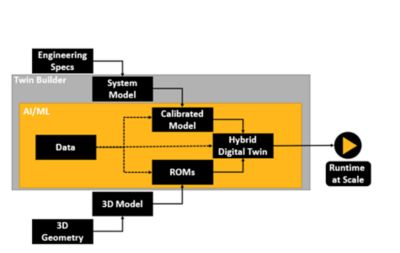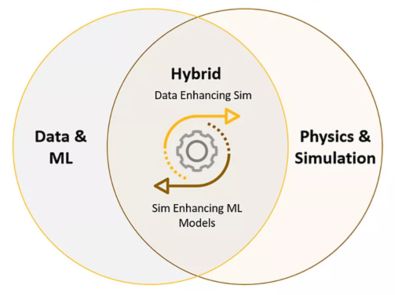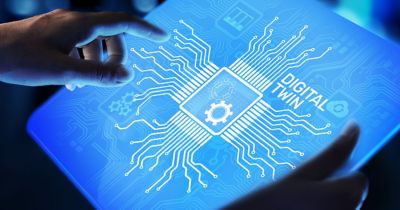-
United States -
United Kingdom -
India -
France -
Deutschland -
Italia -
日本 -
대한민국 -
中国 -
台灣
-
-
产品组合
查看所有产品Ansys致力于通过向学生提供免费的仿真工程软件来助力他们获得成功。
-

您可能听说过数字孪生:根据数字孪生联盟(DTC,Digital Twin Consortium)的信息,数字孪生是“真实世界实体和流程的虚拟表示,按指定的频率和保真度同步”。但什么是混合数字孪生,如何创建呢?实质上,混合数字孪生通过融合数据和物理模型来提高数字孪生的价值。通过集成人工智能/机器学习(AI/ML),您可使用Ansys Twin Builder基于仿真的数字孪生平台和Ansys TwinAI AI支持的数字孪生软件创建混合数字孪生。
Ansys产品市场营销高级经理Asmaa Lapouge 在Ansys《The Twin Talks》系列访谈节目中探讨了混合数字孪生。最近,她与两位Ansys专家对话,概括介绍了混合数字孪生,包括常见应用和使用案例。以下是上述访谈的一些亮点和摘录。
提问:您能简要介绍一下什么是混合数字孪生以及它们与传统数字孪生有何不同吗?
Manzoor TIWANA,Ansys首席产品经理:传统的数字孪生,或者说这些模型的传统方法,要么是纯粹的仿真——例如在Ansys案例中,我们在物理场和仿真领域都非常强大,因此我们拥有这款基于仿真和物理场的模型。许多其他机构则有基于机器学习技术(如AI/ML分析技术)的模型。混合数字孪生,则能够实现将仿真及物理场与AI/ML两个领域的优势强强结合。
提问:在哪些特定行业或应用中,混合数字孪生已显示出重大影响,例如优化运营、改进决策或提高整体性能?

Manzoor Tiwana
MT:在Ansys,我们的客户几乎遍及所有行业。我们拥有来自航空航天、汽车、制造、医疗、能源以及石油和天然气等领域的客户。这些客户正在做的事情,或者说他们面临的挑战是:如何以非常准确的方式表示这些资产或流程,同时使其变得非常快速且可扩展。
我们有一位客户,正在将这种混合数字孪生应用于流体网络中,该网络包括手柄、阀门、管道系统,可以帮助他们预测组件的故障,然后帮助他们优化运行以提高能效。因此,这可以成为优化运行和预测故障的目标。此外,我们还在IEEE上发表了一篇关于该使用案例的论文,这篇论文表明,通过纯分析方法,他们达到了约80%的精度。这可能会因情况而异,但在上述情况下,其精度约为80%,而且使用仿真后,他们实现了约90%的精度。当他们将这两种方法结合起来时,精度则达到了98%。……再则,我们有一位客户使用这项技术来预测其发动机的排放,他们使用这种混合方法减少了必须执行的仿真次数。他们可将仿真和真实数据相结合,快速获得这些结果,因此他们不必执行那么多次仿真,就能获得更高的精度,他们可以将这两者结合在一起,很快达到目的。
提问:从Ansys角度来看,您能告诉我们,该公司如何将混合数字孪生整合到其解决方案中,以及分析仿真在创建物理资产整体表示的过程中所发挥的作用吗?
MT:Twin Builder软件是我们的产品,可帮助构建基于物理场的数字孪生,然后我们有用于执行AI/ML集成的TwinAI平台。TwinAI平台允许工程师将数据和物理场融合,创建先进的数字孪生。因此,用户还可执行参数校准和融合等操作来创建他们的模型,将物理场和传感器数据结合到他们的模型中。
提问:在产品阶段,数字孪生的运用方式是什么?有哪些使用案例?
VITOR LOPES, Ansys产品销售高级经理:与所有优良技术一样,数字孪生的魅力就在于:它非常、非常灵活,适用于各种场景。因此,如果您具体讨论的是已经拥有资产并将其连接到数字孪生的操作或环境,那么您可能会采用这种方式(我最喜欢的一种方式)——将数字孪生用作虚拟传感器,然后在资产运行过程中,获取可以测量的内容,并将其用于测量难以测量的内容,而且您可以将其应用到不同的场景中。您可以先将其用于监控,用于控制,或者将其用于优化。然后,您甚至可以将其用于预测诸如以下情况:“资产何时可能出故障?如果知道了出故障的时间,就可以提前维修,最大限度降低与意外停机有关的成本。”这就是设备运行领域的情况。

Vitor Lopes

构建混合数字孪生时有两种方法:自上而下,以及自下而上。
现在,假设您处于一个已完成项目设计的场景中。您要将设计导出,用于真实环境,但您仍处于调试阶段。那么,您可以先将其更多地应用于数字孪生体,以最大限度减少调试时间和风险。因为即便在产品构建之前,您也可以开始了解,“我将如何使用该产品?在哪些情况下,现场或者生产线上可能会发生一些问题?”可以探索各种不同的使用案例。
最后,早在产品开发早期,您可能就只有一个数字原型。在这个阶段,设备资产实际上还不存在,您的设计仍在进行中,但您已经能够使用模型来验证设计、优化设计,并了解在不同性能下运行的更佳方式。这就是虚拟原型设计、虚拟验证以及决定传感器布置位置的概念。
提问:您能否分享一些具体示例来说明数字孪生在各个领域的影响?
Vitor Lopes:比如能源、五金和采矿等行业,这些行业的作业条件非常恶劣,但同时需要极为严格的工作控制。他们可能会使用数字孪生来了解资产或系统中的特定点,即所谓的虚拟传感器。在过去,与之相关的工作方式比较盲目,人们确实不知道那些位置发生了什么情况,直到连接了孪生,人们才能了解到“这里的温度太高,压力太低”等情况,这可能会促进运营,从而提高产量或最大限度降低风险、成本或性能退化。

混合数字孪生结合了数据、物理场和人工智能/机器学习(AI/ML)技术,可提供最精确的资产表示。
现在,混合数字孪生的应用可能会出现在制造环境中,但我们也发现,航空航天与国防产业也出现了很多例子,人们实际正在将数字孪生连接至飞行器,从而以更精确的方式了解需要进行维护的时间……。因为现在有了混合数字孪生,您就既拥有了数据,也有了物理场,从而能够解实际发生的情况,以及如果出现故障,您能够了解出现故障的原因和位置。
如欲了解更多详情,敬请观看网络研讨会“Ansys TwinAI:将物理精度与数据驱动型洞察完美结合。
Advantage博客
Ansys Advantage博客(The Advantage Blog)由Ansys专家和其他技术专家撰写,让您随时了解Ansys如何为创新赋能,推动人类踏上伟大征程。














